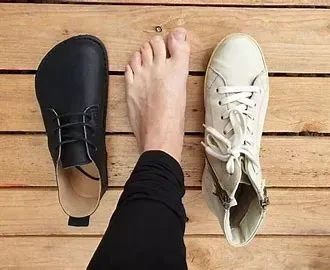
Shoes On or Shoes Off? The Art and Science of Indoor Footwear
The moment you step through your front door, a subtle but significant decision often presents itself: Do you keep your shoes on or kick them off? This isn't just about comfort or cultural habit; it has real implications for your foot health and overall well-being. Let's delve into the "art and science" behind this everyday choice.
The Case for Wearing Shoes Indoors: Support, Protection, and Stability
For many, particularly those with existing foot conditions or certain lifestyle factors, keeping a pair of supportive shoes on indoors offers considerable benefits. According to (Haupt, 2024), benefits include:
Continuous Support and Stability: Our modern homes often feature hard surfaces like hardwood, tile, and concrete. Walking barefoot on these unforgiving surfaces for extended periods can strain the feet, leading to conditions like plantar fasciitis, arch pain, or metatarsalgia. Supportive indoor shoes or slippers provide crucial cushioning and arch support, reducing pressure and promoting proper foot alignment. This is especially beneficial if you use custom orthotics, as wearing them indoors ensures continuous therapeutic support.
Protection from Hazards: Accidents happen. Stepping on a stray Lego brick, a dropped utensil, or even just stubbing a toe can be painful and lead to injury. Shoes act as a protective barrier against these common household hazards. This is particularly important for individuals with neuropathy (nerve damage), such as those with diabetes, who may not feel minor injuries that could lead to serious complications.
Improved Balance and Posture: Good footwear can help maintain proper body mechanics, which is vital for balance and posture. This benefit becomes even more pronounced with age, as natural cushioning in the feet diminishes, and the risk of falls increases. Supportive indoor shoes can provide the stability needed to reduce slip and trip hazards on smooth floors.
Warmth and Circulation: For individuals with cold feet or poor circulation, indoor shoes or supportive slippers can offer much-needed warmth and comfort, preventing discomfort.
The Case for Going Barefoot Indoors: Strengthening and Cleanliness
Conversely, shedding your shoes indoors has its own set of advantages, particularly in terms of foot muscle development and home hygiene. According to (LetzBarefoot, n.d) benefits include:
Strengthening Foot Muscles: Walking barefoot allows the intrinsic muscles of the feet to engage more naturally. These muscles, often underutilized in constantly shod feet, play a vital role in foot stability and movement. Short, intentional periods of barefoot walking on softer surfaces like carpet can help strengthen these muscles.
Improved Foot Skin Health: Going barefoot allows the skin on your feet to breathe, reducing moisture buildup that can contribute to fungal infections like athlete's foot. It also offers a natural exfoliation effect on various surfaces.
Enhanced Sensory Input ("Grounding"): For some, walking barefoot provides a sensory experience that can be relaxing and contribute to a feeling of "grounding" or connection with their immediate environment.
Cleaner Home Environment: Perhaps the most compelling argument for going shoeless indoors is preventing the tracking in of dirt, germs, and toxins. Studies have shown that shoe soles can harbor a surprising array of bacteria (including E. coli), allergens (like pollen and dust), and even harmful chemicals (such as lead or pesticides) from the outdoor environment. Removing shoes at the door helps maintain a healthier and cleaner indoor living space, especially important for households with young children or pets who spend time on the floor.
Protecting Floors and Carpets: Removing shoes prevents scratches, scuffs, and premature wear on hardwood floors, and reduces the grinding of dirt into carpets, extending their lifespan.
Finding Your Foot-Friendly Balance
There's no single "right" answer for everyone. The best approach often involves a balanced consideration of your individual foot health, activity levels, home environment, and personal preferences.
Consider Dedicated Indoor Footwear: For those who need support but want to maintain a clean home, a pair of supportive indoor-only shoes or orthopedic slippers can be an ideal compromise. Look for options with good arch support, cushioning, and a secure fit.
Strategic Barefoot Time: If you enjoy being barefoot, incorporate it strategically. Walk barefoot on softer surfaces like carpet for short periods to engage foot muscles, but opt for supportive footwear when performing tasks that involve prolonged standing (e.g., cooking) or on hard, unyielding floors.
Prioritize Protection: If you have conditions that compromise foot sensation (like diabetes) or are prone to falls, prioritize protective and supportive footwear indoors to minimize injury risk.
Ultimately, understanding the benefits and drawbacks of each approach empowers you to make an informed decision that supports the long-term health and comfort of your feet. Listen to your body, observe your home environment, and consult with a foot care professional if you have specific concerns.
References:
Haupt, A. (2024, March 19). Should you wear shoes in the house?. Time. https://time.com/6917608/should-i-wear-shoes-in-the-house/
LetzBarefoot, A. (n.d.). The evolution of the human foot: Benefits of barefoot walking and minimalist shoes. LetzBarefoot SARL. https://www.letzbarefoot.com/en/blog/post/the-evolution-of-human-feet-why-were-designed-for-barefoot-walking_22.html?page_type=post